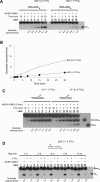Human MUS81-EME2 can cleave a variety of DNA structures including intact Holliday junction and nicked duplex
- PMID: 24692662
- PMCID: PMC4027171
- DOI: 10.1093/nar/gku237
Human MUS81-EME2 can cleave a variety of DNA structures including intact Holliday junction and nicked duplex
Abstract
MUS81 shares a high-degree homology with the catalytic XPF subunit of the XPF-ERCC1 endonuclease complex. It is catalytically active only when complexed with the regulatory subunits Mms4 or Eme1 in budding and fission yeasts, respectively, and EME1 or EME2 in humans. Although Mus81 complexes are implicated in the resolution of recombination intermediates in vivo, recombinant yeast Mus81-Mms4 and human MUS81-EME1 isolated from Escherichia coli fail to cleave intact Holliday junctions (HJs) in vitro. In this study, we show that human recombinant MUS81-EME2 isolated from E. coli cleaves HJs relatively efficiently, compared to MUS81-EME1. Furthermore, MUS81-EME2 catalyzed cleavage of nicked and gapped duplex deoxyribonucleic acids (DNAs), generating double-strand breaks. The presence of a 5' phosphate terminus at nicks and gaps rendered DNA significantly less susceptible to the cleavage by MUS81-EME2 than its absence, raising the possibility that this activity could play a role in channeling damaged DNA duplexes that are not readily repaired into the recombinational repair pathways. Significant differences in substrate specificity observed with unmodified forms of MUS81-EME1 and MUS81-EME2 suggest that they play related but non-overlapping roles in DNA transactions.
© The Author(s) 2014. Published by Oxford University Press on behalf of Nucleic Acids Research.
Figures








References
-
- Kuzminov A. Collapse and repair of replication forks in. Escherichia Coli Mol. Microbiol. 1995;16:373–384. - PubMed
-
- Cox M.M., Goodman M.F., Kreuzer K.N., Sherratt D.J., Sandlerk S.J., Marians K.J. The importance of repairing stalled replication forks. Nature. 2000;404:37–41. - PubMed
-
- Kowalczykowski S.C. Initiation of genetic recombination and recombination-dependent replication. Trends Biochem. Sci. 2000;25:156–165. - PubMed
-
- Higgins N.P., Kato K., Strauss B. A model for replication repair in mammalian cells. J. Mol. Biol. 1976;101:417–425. - PubMed
Publication types
MeSH terms
Substances
LinkOut - more resources
Full Text Sources
Other Literature Sources
Molecular Biology Databases

